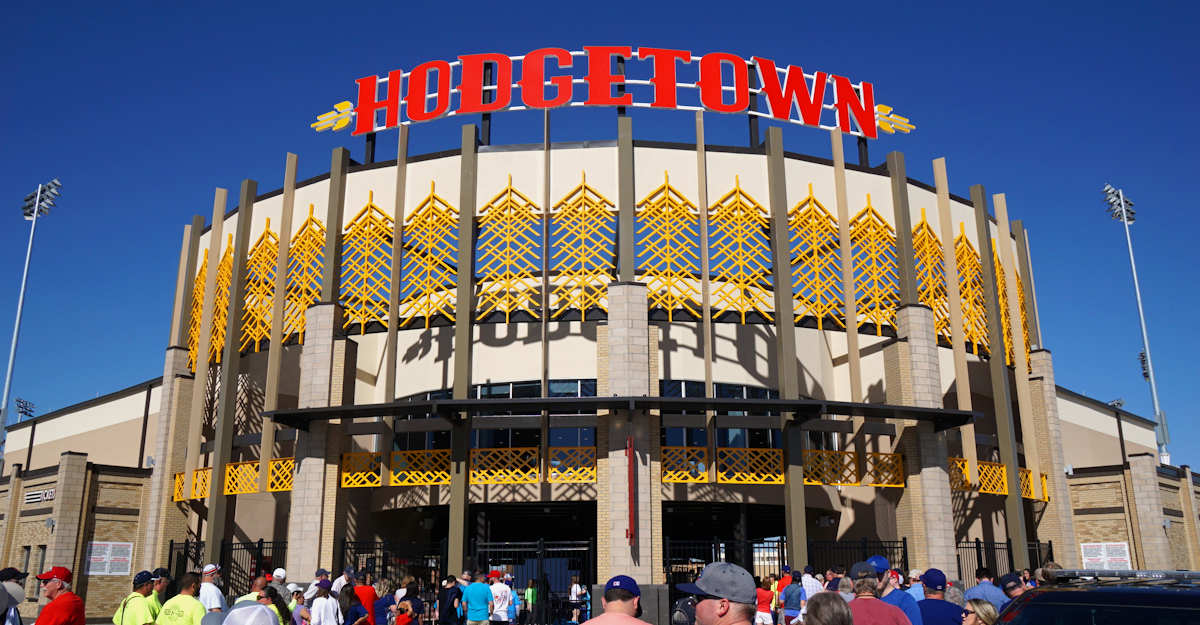
Article and all photos by Joe Mock, BaseballParks.com
All rights reserved
AMARILLO, TEXAS After 51 straight years in the Texas League, it’s hard to imagine that there’s no San Antonio in the standings any more.
| Ballpark Stats |
 |
| Team: Amarillo Sod Poodles of the Double-A Texas League |
| First game: April 8, 2019, a 9-4 loss to Midland |
| Capacity: 7,000, including 4,269 fixed seats plus room for 2,362 on berms and social spaces, and 369 standing room |
| Dimensions: LF – 325; LCF – 345; CF – 400; RCF – 375; RF – 325. The wall is 16′ tall in LF and CF, 8′ in RF |
| Architect: Populous. Lead Project Designer – Mike Sabatini; Lead Project Architect – Brian Simpson |
| Construction: joint venture of local firm Western and national firm Hunt |
| Price: $45.5 million |
| Home dugout: 3B side |
| Field points: East by northeast |
| Playing surface: Latitude Bermudagrass |
| Naming rights: honors Jerry Hodge, local prescription company owner and tireless supporter of bringing baseball to Amarillo |
| Ticket info: sodpoodles.com/tickets |
| Betcha didn’t know: The team’s parent is the Padres. On April 8, 1969, exactly 50 years prior to the Sod Poodles’ inaugural game in Amarillo, the Padres played their first game in San Diego. |
How did that happen, and what does that have to do with Amarillo?
Since 1900, San Antonio was absent from the Texas League (or circuits associated with the TL) only six seasons — and three of those were during World War II when most Minor Leagues didn’t operate.
The reason the Alamo City wasn’t in the TL in 1965, ’66 and ’67? The franchise had moved to Amarillo to become the Sonics following the ’64 season.
When San Antonio landed an expansion franchise in the TL in 1968, it held onto it for 51 straight seasons, reeling in six league titles during that time — including five in a 12-year span from 2002-2013.
When the city built Nelson Wolff Municipal Stadium (named for the former mayor and current county judge) in 1994, the facility was roundly applauded as one of the best parks — or perhaps the best — in the Minors. Its site on the west side of the city was praised as being forward thinking, as it was close to two large military bases and was going to be at the intersection of two major highways.
But then time passed. That area of town is no longer considered desirable. While some enhancements were added to the ballpark, the main structure remained unchanged — and fell woefully behind the times.
As you can imagine, the team’s owner, Elmore Sports Group, asked repeatedly for the City to build a new ballpark, preferably close to the hot downtown area. It would’ve made sense, since the City had very good facilities for basketball and hockey (AT&T Center) and for major events (Alamodome) — but Wolff Stadium was decidedly lacking.
Honestly, for a City with the seventh largest population in America, it is embarrassing how inadequate its baseball facility had become.
Other than some vague overtures about possibly providing land, the City appeared uninterested in taking on the cost of constructing a new baseball stadium.
You might think that the City deserved to have its professional baseball franchise yanked away and moved to a municipality that was willing to build a nice, new ballpark.
Well, that’s kind of what happened … but despite the Alamo City’s refusal to build a new park, they ended up with an upgrade in its baseball franchise.
Yes, Elmore decided to pull the Texas League Missions out of San Antonio to a to-be-built park in Amarillo. But at the same time they announced this (in downtown Amarillo on June 21, 2017), they stated that the Triple-A team they own in Colorado Springs would move to San Antonio! Completing the shuffling of the deck, Elmore’s Pioneer League team in Helena, Montana’s substandard park would fill the void being left in Colorado Springs. The Pioneer League team dumped the Sky Sox name and became the Rocky Mount Vibes. (Yes, really.)
One could only view this as dominoes, with Helena to Colorado Springs, Colorado Springs to San Antonio and San Antonio to Amarillo.
Folks in the Texas Panhandle were deliriously happy. Fans in the Rocky Mountain State were mad that they were losing their top-level, full-season team with the replacement being a Rookie Level, short-season squad. Helena wasn’t happy to be losing out all together. Fans in San Antonio seemed, well, to shrug.
| Leaving the bottom of the TL |
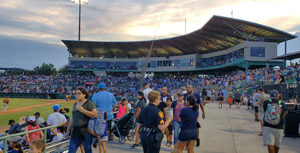 |
| When the San Antonio Missions opened Wolff Municipal Stadium in 1994, it was hailed as one of the top facilities in the Minors. In recent years, though, it was regarded as the worst in the Texas League. So the Missions upgraded significantly in the move to Amarillo. |
By all rights, the Alamo City should’ve lost out completely, and found itself like Albuquerque in 2000, when its PCL team left substandard Albuquerque Sports Stadium for Portland. Affiliated baseball didn’t return until 2003 when Albuquerque built a new stadium. That should’ve been San Antonio’s fate … but oddly it wasn’t. Yes, they lost their longtime Double-A team but ended up with Triple A.
Granted, Elmore probably didn’t want to vacate the market of one of the largest cities in the country, and they are no doubt holding out hope that San Antonio will still build them a new downtown ballpark. Someday.
But as the former Missions were debuting in Amarillo, City officials in San Antonio seem no closer to agreeing to build a park than ever. One has to imagine that Elmore is listening to overtures from other major cities who might be willing to provide a shiny, new stadium. Portland, if they don’t land a Major League expansion team? Monterrey, Mexico, that already has a stadium that hosted MLB regular-season games?
Anything would be an upgrade over The Wolff.
And the fact that there was a precedent half a century ago when the Texas League team moved from San Antonio to Amarillo really means nothing today. I mean, the TL currently operates with half of its eight teams outside of the Lonestar State, so the team could’ve moved to any of a number of attractive markets.
So why did Elmore select Amarillo for Double A and not Triple A? Read about that in our next section.
So the relocated Missions wound up in a new stadium dubbed Hodgetown in downtown Amarillo. It opened on April 8. The photo at the top of our Ballpark Stats sidebar box, by the way, is a festive cake I spotted in the front office on the big day.
But is the ballpark worthy of the Texas League, a circuit with five former BaseballParks.com Ballpark of the Year titles (Midland, Frisco, Springfield, Arkansas, Northwest Arkansas), and two others that are exceptionally nice (Corpus Christi and Tulsa)? Read on to find out!
The Setting
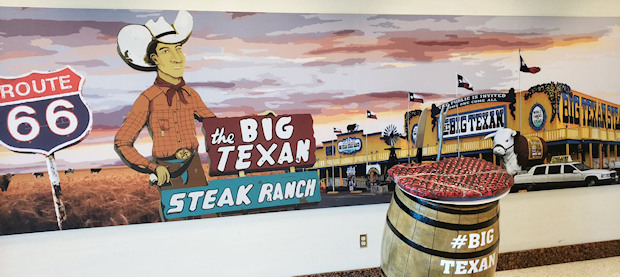
So when the Elmore Sports Group was lining up the dominoes to knock over, why didn’t they move the Triple-A Sky Sox to a new park in Amarillo? Hodgetown ended up being tremendously nicer than Wolff Stadium — but, of course, that wasn’t all that difficult.
The issue is two-fold: market size and corporate sponsors. Amarillo is the 117th largest city in the U.S., with about 200,000 within its city limits. If you look at the overall metro area, Amarillo is 182nd, with a population of about 236,000. It is not the home of the headquarters for any Fortune 500 Companies. Or Fortune 1000 Companies.
By comparison, San Antonio is the seventh largest city in the U.S. and is the home of four Fortune 500 Companies.
So Amarillo isn’t a Triple-A city — although its new ballpark is prettier than most current Triple-A facilities. And its size doesn’t mean that it can’t support a Texas League franchise, although its attendance figures might not rival mighty Frisco for the league lead.
As you probably know, Amarillo is in the Panhandle of Texas. It’s not the biggest city in the Panhandle — that distinction belongs to Lubbock, the 83rd biggest in the U.S. — but it has shown steady growth in population and economic measures in recent years. And just as importantly, it had civic backing for bringing pro baseball to town.
What is Amarillo known for? Well, if you’ve driven along I-40 across New Mexico or Oklahoma, you’ve no doubt seen the billboards enticing you to take advantage of the free 72-ounce steak at the Big Texan Steak Ranch. If you’ve flown into Amarillo’s airport, you’ve probably seen the huge mural shown in the photo above.
If you dine at Big Texan and eat the entire steak meal within 60 minutes, then you don’t have to pay. Many have tried, but most have ended up paying the $72 for the meal. Most locals will tell you there are lots and lots of restaurants that are better than the tourist-attracting Steak Ranch. Personally, I’ve never been that impressed with the food there.
But it’s undoubtedly the best-known eatery in Amarillo.
The most famous attraction in the area? That’s probably the Cadillac Ranch just west of town, where ten Cadillacs are partially buried in the ground along I-40.
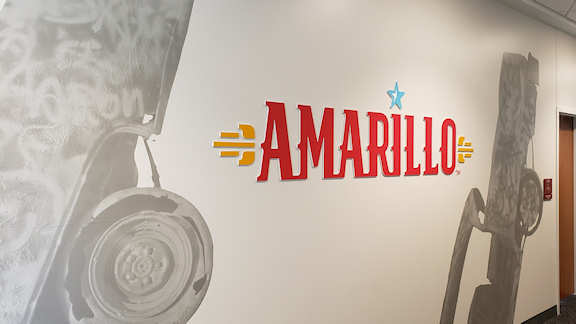 Along the hallways of the upper level of Hodgetown, there are murals that depict famous scenes from the area, like the Cadillac Ranch. There’s similar artwork showing the Palo Duro Canyon and helicopters, because Bell Helicopter has an assembly plant in Amarillo. Along the hallways of the upper level of Hodgetown, there are murals that depict famous scenes from the area, like the Cadillac Ranch. There’s similar artwork showing the Palo Duro Canyon and helicopters, because Bell Helicopter has an assembly plant in Amarillo. |
The most famous geological feature? Assuredly, it’s Palo Duro Canyon, to the south of Amarillo. It’s the second biggest canyon in the U.S.
While Big Texan isn’t memorialized in Hodgetown, the Cadillac Ranch and Palo Duro are. (See above)
When conversations commenced between Elmore and Amarillo, City leaders were increasingly interested in undertaking some “urban renewal” to the downtown area. In fact, Coca-Cola had operated a bottling plant near Buchanan Street on the edge of the City’s center since 1927, but they desired an enlarged facility at a different site in town. The Amarillo Economic Development Corp. engineered a land swap that permitted Coke to open a new plant in 2015. That left the old site available for something new … which ended up being Hodgetown.
The location worked on a number of levels. It would allow the City to build a showy facility to attract people downtown, while acting as a bridge to the replacement of several blocks of more run-down structures just to the east. By virtue of the site being across the street from City Hall and a block and a half from the existing civic center, it would take advantage of existing parking while also providing the catalyst to construct a new parking garage.
Amarillo would have the critical link needed to implement a larger renewal plan, and residents would have professional baseball, as well as a facility for non-baseball events.
Over the 37 years since a Texas League franchise had left town, the market had seen a series of independent-league teams play in dilapidated Potter County Memorial Stadium well east of downtown. Naturally, City leaders assumed that they would be building a facility for another indy team … but why shoot for that if you can land an affiliated Minor League franchise? The arrangement between Elmore and the City brought that best-case scenario to fruition.
A non-binding referendum went on the ballot in May of 2015, and local voters indicated they were in favor of the ballpark plan by a narrow 52%-48% margin.
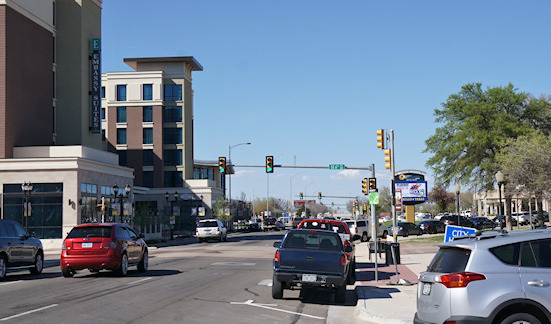 From the third-base exterior of Hodgetown looking north on Buchanan Street, you have the new Embassy Suites on the left. The city’s municipal complex with City Hall and the Civic Center is on the right. From the third-base exterior of Hodgetown looking north on Buchanan Street, you have the new Embassy Suites on the left. The city’s municipal complex with City Hall and the Civic Center is on the right. |
So there was a green light for the former Coke plant land to be used for the ballpark. It was to join a rapidly growing list of new construction within a couple of blocks. This included the beautiful new headquarters for Xcel Energy, an Embassy Suites Hotel, a new parking garage and retail space — all along the west side of Buchanan Street, with the ballpark being on the east side. Planned further to the east are apartments and eating/drinking establishments.
What about the parcel of land dedicated to the ballpark? We’ve seen lots of examples of local governments wanting to devote land no one else wants to a baseball stadium, and then the designers of the park have fits because the land is ill-suited for a sports facility.
Not here. “This is one of the better sites we’ve worked on,” said Mike Sabatini, Lead Project Designer at architecture firm Populous. “We were able to get everything we wanted on the site.” This included some parking, all of the amenities and facilities the team wanted, and somewhat of a buffer between the park’s exterior and traffic on the surrounding streets — and the playing field could have the orientation preferred by Major League Baseball. Plus the lot was flat, didn’t have a horrible problem with layers of rock just beneath the surface or have a high water table. Sabatini added with a grin, “It was kind of refreshing.”
In other words, the site didn’t present insurmountable problems to the architects — but there was one peculiarity unique to Amarillo.
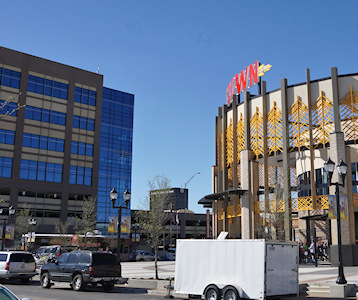 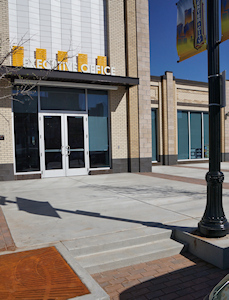 |
| The headquarters for Xcel Energy is directly across Buchanan Street from the entry of Hodgetown. Also, you can see that the sidewalk (and consequently the concourse of the park) is elevated from the street. |
One assumes there was a lack of foresight by planners many decades ago, because the sewer system below Amarillo’s streets isn’t sufficient to handle all of the runoff water during a downpour. “That means that they use the streets as kind of a viaduct,” Sabatini explained. “That’s why the sidewalks are elevated above the streets, so our concourse had to be about a foot above street level. That’s something that is unique about this site.” That necessitated a step or two up from the curb onto the sidewalks that lead into the park.
A lot of traffic passing through downtown uses Buchanan, which is one-way running north. “That’s why the signature piece of the park, the entry rotunda, is there,” he added. “It gives you a ‘wow’ moment when you see it driving up Buchanan.”
So let’s explore more about the ballpark’s exterior.
The Exterior
The way the dominoes lined up perfectly for Amarillo to land a Double-A franchise, you might think that the City’s new ballpark might have an exterior of rectangular black tiles with different arrangements of white dots.
No, nothing that far fetched.
| The designers |
 |
| Although many folks at Populous work on any given project, these are the two chiefly responsible for the look of Hodgetown: Brian Simpson, Lead Project Architect; Mike Sabatini, Lead Project Designer. (Photo courtesy of POPULOUS) |
But would you believe art deco? Sabatini explained that Populous conducted research of building exteriors in Amarillo, and discovered that “A major look in town is what we call Midwestern Art Deco. You see it in buildings from Chicago to Kansas City to Tulsa to Amarillo. It’s not the kind of art deco with lots of ornamentation you’d see in Miami. Here there is more grill-work with the use of heavy stone.”
As for the aforementioned signature element of the park’s entryway, “We looked at Amarillo’s bank buildings and theaters, and what we came up with was the rotunda with lots of grill-work and verticality. It’s Midwestern Art Deco that fits in the downtown.”
That rotunda is shown at the top of this page. It’s stunning — the kind of showy, impressive entryway that you’d find at a Major League ballpark or a very significant theater. It’s the kind of element that might be proposed for a Minor League park, but would invariably be chopped when costs would start to mount.
Once you see it, you’ll be glad they kept the ostentatious “front door” of Hodgetown in the plans.
There are also towers down both baselines that act as bookends to the main structure. They feature more of the art-deco look. This gives Hodgetown a lovely, well-coordinated exterior. Rather than a series of different structural elements stuck together (like at many parks), it shows a certain vision behind the ballpark’s overall look.
 This is the entry plaza near the left-field foul pole. To the right is one of the two towers (the other being down the first-base line) in all of its art-deco showiness. This is the entry plaza near the left-field foul pole. To the right is one of the two towers (the other being down the first-base line) in all of its art-deco showiness. |
There is a great deal of intentionality behind the colors and building materials used in the masonry running from the rotunda down the baselines. Sabatini said the “color and striations of the exterior materials were inspired by the Palo Duro Canyons,” adding that they picked up those same striations in the dividing walls of the field suites and lounge inside.
While the main entryway to the park is the photogenic rotunda behind home plate, more fans are likely to enter through the gates near the left-field foul pole, close to City Hall. There’s a plaza here (see photo above) with ticket windows and a door into the merchandise shop to be used when there’s no game going on.
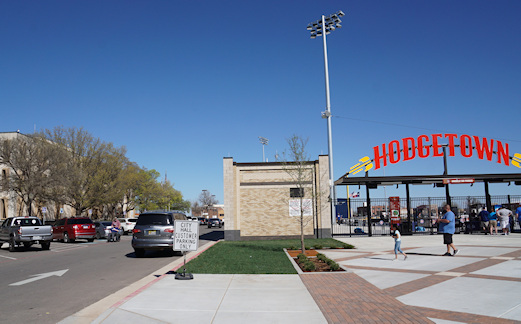 This is taken from the intersection of Buchanan and 6th Avenue looking east, with City Hall to the left. Since there is more parking and commerce near this entryway, it’s likely to be used more heavily than the fancier one behind home plate. This is taken from the intersection of Buchanan and 6th Avenue looking east, with City Hall to the left. Since there is more parking and commerce near this entryway, it’s likely to be used more heavily than the fancier one behind home plate. |
The perimeter of the ballpark beyond the outfield concourse is mostly an iron fence, one that is easy to see through. We’ve seen a number of fairly new parks (Arkansas, Charlotte, El Paso) employ this as sort of an invitation to those passing by to take a peak inside and be lured into buying a ticket.
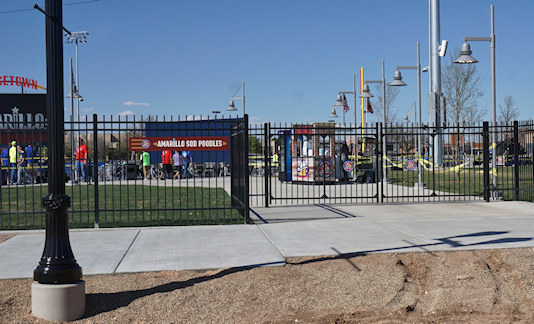 This break in the iron fencing near the right-field foul pole could be used as an entryway someday. Of course, following all of the heavy construction that had just taken place here building the ballpark, this part of 8th Avenue isn’t even paved as of Opening Day. This break in the iron fencing near the right-field foul pole could be used as an entryway someday. Of course, following all of the heavy construction that had just taken place here building the ballpark, this part of 8th Avenue isn’t even paved as of Opening Day. |
There’s basically only one break in that fence that could be considered an entryway. It’s on the south side along 8th Avenue, beyond first base. It could be used as an entry gate, but isn’t yet. If more parking or development occurs to the south and east of the ballpark, perhaps the team will start using it.
The art-deco exterior is beautiful … but what does the interior look like? Keep reading!